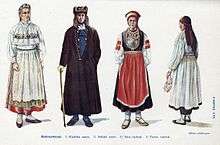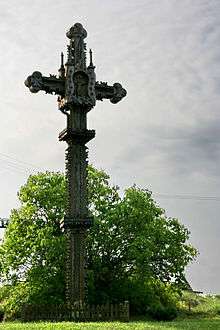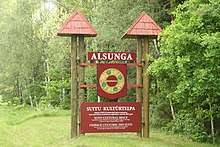List of Intangible Cultural Heritage elements in Northern Europe
Northern Europe comprises Denmark, Estonia, Finland, Iceland, Ireland, Latvia, Lithuania, Norway, Sweden, and the United Kingdom,[1] and the following dependent territories: the Faroe Islands controlled by Denmark, the Åland Islands controlled by Finland, Svalbard and Jan Mayen controlled by Norway, and the British Crown dependencies, Guernsey and Jersey, and the Isle of Man.[1] Out of these, the United Kingdom is not yet party to the Convention for the Safeguarding of the Intangible Cultural Heritage by The United Nations Educational, Scientific and Cultural Organization (UNESCO).[2] The convention was drafted in 2003,[3] and taking effect in 2006.[2]
According to the convention, intangible cultural heritage elements are components of the cultural heritage within a territory that are equally as important as physical cultural elements, like World Heritage Sites.[4] The elements are abstract and must be learned, encompassing traditional knowledge which includes festivals, music, performances, celebrations, handicrafts, and oral traditions. Intangible cultural heritage is based on the opinions of local communities, as according to the convention there needs to be stakeholders viewing the elements as "their heritage".[5] The member states undertake to create one or several inventories of the intangible cultural heritage within their territory.[5] This work is ongoing in Northern Europe.
UNESCO upholds two international lists of intangible cultural heritage, the Representative List of the Intangible Cultural Heritage of Humanity and the List of Intangible Cultural Heritage in Need of Urgent Safeguarding.[6] The member states apply for cultural elements to be added to the international lists. The Intergovernmental Committee for the Safeguarding of Intangible Cultural Heritage, which approves new inscription requests, and a definition of "intangible cultural heritage".[3] As part of the convention, the UNESCO also upholds the Register of Good Safeguarding Practices that contains that reflect the principles of the convention - that is to uphold living traditions.[6] No cultural elements from Northern Europe have been included on the List of Intangible Cultural Heritage in Need of Urgent Safeguarding.[7]
Inventories of intangible cultural heritage in Northern Europe
| Country/Territory | List(s) of intangible cultural heritage | National authority in charge | Established |
|---|---|---|---|
| Estonia | Estonian Inventory of Intangible Cultural Heritage | Estonian Folk Culture Centre | 2007 |
| Denmark | Living culture – an inventory of intangible cultural heritage in Denmark | The Danish Folklore Archives at The Royal Danish Library | 2017 |
| Finland | Wiki-inventory for living heritage | National Board of Antiquities | 2016
2017 |
| Greenland | Intangible cultural heritage inventory | Greenland National Museum & Archives | ? |
| Iceland | - | the Ministry of Education, Science and Culture | |
| Ireland | National Inventory of Intangible Cultural Heritage | Department of Culture, Heritage and the Gaeltacht | 2016 |
| Latvia | Nemateriālā kultūras mantojuma saraksts | National Culture Center of Latvia | ? |
| Lithuania | The Inventory of Intangible Cultural Heritage of Lithuania | Lithuanian National Culture Centre | 2015 |
| Norway | Immateriell kulturarv | Arts Council | ? |
| Scotland | ICH Scotland | Museums Galleries Scotland | 2011 |
| Sweden | Living traditions - an inventory of intangible cultural heritage in Sweden | The Institute for Language and Folklore | ? |
| United Kingdom | - |
Cultural elements from Northern Europe on the Representative List
Six intangible cultural heritage elements on UNESCO's representative list originate from the region. Three have been inscribed as elements of Estonia and Lithuania, two as elements of Latvia, one for Ireland, and none for Denmark, Finland, Iceland, Norway, Sweden, and the United Kingdom. Estonia, Lithuania, and Latvia share one cultural heritage element.[8]
The table lists information about each International Cultural Heritage element:
- Name: official name, worded as inscribed on the list
- Region: region within or outside a country where a heritage is still practiced
- Country: country, as inscribed on the list
- Year: the year the site was inscribed on the Intangible Cultural Heritage List
- Session: the session and decision in which a heritage is inscribed by the committee[nb 1]
- Description: brief description of the heritage
- Site: official UNESCO page


| Name | Region | Country | Year | Session | Description | Site |
|---|---|---|---|---|---|---|
| Baltic song and dance celebrations | Baltic states | 2008 | 3.COM | UNESCO has inscribed the folk festivals of the Baltic countries, which celebrate the region's heritage of dancing and musical performances. Three events are directly mentioned.[8] The first is the Estonian Song Festival, held once every five years.[9] The event was first held in 1869,[10] when the region was still under the control of Tsarist Russia.[11] The second, the Latvian song festival, is also held every five years, beginning in 1873.[8] The third is the Lithuanian Song and Dance Celebration, held once every four years. The festival originates in Kaunas, and was first celebrated in 1924.[12] The Baltic celebrations attract participants and visitors from around the world.[12] All three events served as a celebration of national pride, and continued, even under the rule of the Soviet Union.[8] During the fall of Communism, revolutions in the region were dubbed "Singing Revolutions", a name derived from the influence of folk festivals on the drive for independence.[11] | .[8] | |
| Kihnu cultural space | Kihnu island and Manilaid island in the Baltic Sea | 2008 | 3.COM | UNESCO has inscribed the cultural practices of the Kihnu people. This includes the sealing and fishing traditionally performed by the men, the farming traditionally performed by the women, and the musical performances, celebrations, and handicrafts of the community.[13] The Kihnu people have retained the tradition of performing runic songs, a form of song that predates Christianity.[14] Kihnu clothing, made of wool, are covered with colourful decorations, which serve as representations of the mythology of the community.[13] | .[13] | |
| Seto Leelo, Seto polyphonic singing tradition | Southeastern Estonia and the Pechorsky District of Pskov Oblast, Russia | 2009 | 4.COM 13.38 | The performance of leelo, a tradition practiced by the Seto people, has been inscribed as an intangible cultural heritage.[15] Leelo is a form of polyphonic singing performed by participants, usually women,[15] dressed in traditional clothing.[16] During the Seto Kingdom Day celebration, the winning lead singer of a leelo group is awarded the title of "Mother of Song".[15] | .[15] | |
| Suiti cultural space | Western Latvia | 2009 | 4.COM 14.07 | The culture and traditions of the Suiti people are inscribed as an intangible cultural heritage. This includes the community's festivals, celebrations, food, folk clothing, religious practices, language, and dance and musical performances.[17] Living in a region that is largely Protestant, the Suiti people are followers of Catholicism, a belief system that survived the Latvian Soviet Socialist Republic era.[17] | .[17] | |
| Cross-crafting and its symbolism | National | 2008 | 3.COM | Cross-crafting, the art of creating crosses, is a tradition in Lithuania. The practice is part of the Roman Catholic tradition in the region.[18] | .[18] | |
| Sutartinės, Lithuanian multipart songs | Northeastern Lithuania | 2010 | 5.COM 6.26 | Sutartinės is a form of Lithuanian folk music. The polyphonic songs are performed during celebrations.[19] | .[19] | |
| Uilleann piping | Ireland | 2017 | 12.COM 11.b.16 | The practice of playing the uilleann pipes, a highly developed form of bagpipes for playing Irish traditional music | .[20] | |
| Hurling & Camogie | Ireland | 2018 | 13.COM | The bat and ball sports originating in Gaelic culture. | .[21] | |
Total heritage elements by country
Exclusive heritage elements are those that are inscribed as a heritage of a single country. Shared heritage elements are inscribed as elements of multiple countries. As of 3 November 2012
| Country | Exclusive elements | Shared elements | Ref. |
|---|---|---|---|
| — | — | [22] | |
| 2 | 1 | [23] | |
| — | — | [24] | |
| — | — | [25] | |
| 1 | — | [26] | |
| 1 | 1 | [27] | |
| 2 | 1 | [28] | |
| — | — | [29] | |
| — | — | [30] | |
| — | — | [31] |
Entries from Northern Europe in the Register of Good Practices
The first entry from Northern Europe in the Register of Good Practices was accepted in 2018. The Land-of-Legends programme in Kronoberg Region (South-Sweden) was added for promoting and revitalizing the art of storytelling.[7] The organization behind the Land-of Legends programme is the Storytelling Network of Kronoberg, an accredited NGO within the system of the Convention for the Safeguarding of the Intangible Cultural Heritage.[32][33]
Notes
- The .COM abbreviation is used by UNESCO for committee sessions. 3.COM represents the third session of the committee, 4.COM represents the fourth session, and so on.
References
- "Composition of macro geographical (continental) regions, geographical sub-regions, and selected economic and other groupings". United Nations Statistics Division. Retrieved 24 October 2012.
- "The States Parties to the Convention for the Safeguarding of the Intangible Cultural Heritage (2003)". UNESCO.
- "Text of the Convention for the Safeguarding of Intangible Cultural Heritage". UNESCO. Retrieved 24 October 2012.
- "State Parties". UNESCO. Retrieved 24 October 2012.
- "UNESCO - Text of the Convention for the Safeguarding of the Intangible Cultural Heritage". ich.unesco.org. Retrieved 2019-02-22.
- "UNESCO - Purpose of the Lists of Intangible Cultural Heritage and of the Register of Good Safeguarding Practices". ich.unesco.org. Retrieved 2019-02-22.
- "UNESCO - Browse the Lists of Intangible Cultural Heritage and the Register of good safeguarding practices". ich.unesco.org. Retrieved 2019-02-22.
- "Baltic song and dance celebrations". UNESCO. Retrieved 3 November 2012.
- Kurm, Kairi (8 July 1991). "A new verse in the Song Festival". Baltic Times. Retrieved 4 November 2012.
- Tallinn, BC (6 October 2009). "Tiny Estonia tunes up for giant national-pride choir". AFP. Retrieved 4 November 2012.
- Mardiste, David. "Crisis can't dampen Estonia's traditional song fest". 6 July 2009. Reuters. Retrieved 4 November 2012.
- Juodelyte-Moliboga, Karina (4 July 2007). "Lithuania bursts into song and dance". Baltic Times. Retrieved 4 November 2012.
- "Kihnu cultural space". UNESCO. Retrieved 3 November 2012.
- Jaan Ross; Ilse Lehiste (2001). The Temporal Structure of Estonian Runic Songs. Walter de Gruyter. p. 13. ISBN 978-3-11-017032-0. Retrieved 4 November 2012.
- "Seto Leelo, Seto polyphonic singing tradition". UNESCO. Retrieved 3 November 2012.
- Kevin O'Connor (2006). Culture And Customs of the Baltic States. Greenwood Publishing Group. p. 178. ISBN 978-0-313-33125-1. Retrieved 5 November 2012.
- "Suiti cultural space". UNESCO. Retrieved 3 November 2012.
- "Cross-crafting and its symbolism". UNESCO. Retrieved 3 November 2012.
- "Sutartinės, Lithuanian multipart songs". UNESCO. Retrieved 3 November 2012.
- "Uilleann piping". UNESCO. Retrieved 13 December 2017.
- "Uilleann piping". UNESCO. 28 November 2018. Retrieved 29 November 2018.
- "Denmark — Information related to Intangible Cultural Heritage". UNESCO. Retrieved 3 November 2012.
- "Estonia — Information related to Intangible Cultural Heritage". Estonia. Retrieved 3 November 2012.
- "Finland — Information related to Intangible Cultural Heritage". UNESCO. Retrieved 3 November 2012.
- "Iceland — Information related to Intangible Cultural Heritage". UNESCO. Retrieved 3 November 2012.
- "Ireland— Information related to Intangible Cultural Heritage". UNESCO. Retrieved 3 November 2012.
- "Latvia — Information related to Intangible Cultural Heritage". UNESCO. Retrieved 3 November 2012.
- "Lithuania — Information related to Intangible Cultural Heritage". UNESCO. Retrieved 3 November 2012.
- "Norway — Information related to Intangible Cultural Heritage". UNESCO. Retrieved 3 November 2012.
- "Sweden — Information related to Intangible Cultural Heritage". UNESCO. Retrieved 3 November 2012.
- "United Kingdom — Information related to Intangible Cultural Heritage". UNESCO. Retrieved 3 November 2012.
- "UNESCO - Land-of-Legends programme, for promoting and revitalizing the art of storytelling in Kronoberg Region (South-Sweden)". ich.unesco.org. Retrieved 2019-02-22.
- "UNESCO - Sweden". ich.unesco.org. Retrieved 2019-02-22.
External links
- UNESCO Intangible Cultural Heritage: Official site
- UNESCO Convention for the Safeguarding of Intangible Cultural Heritage: Text of the convention
